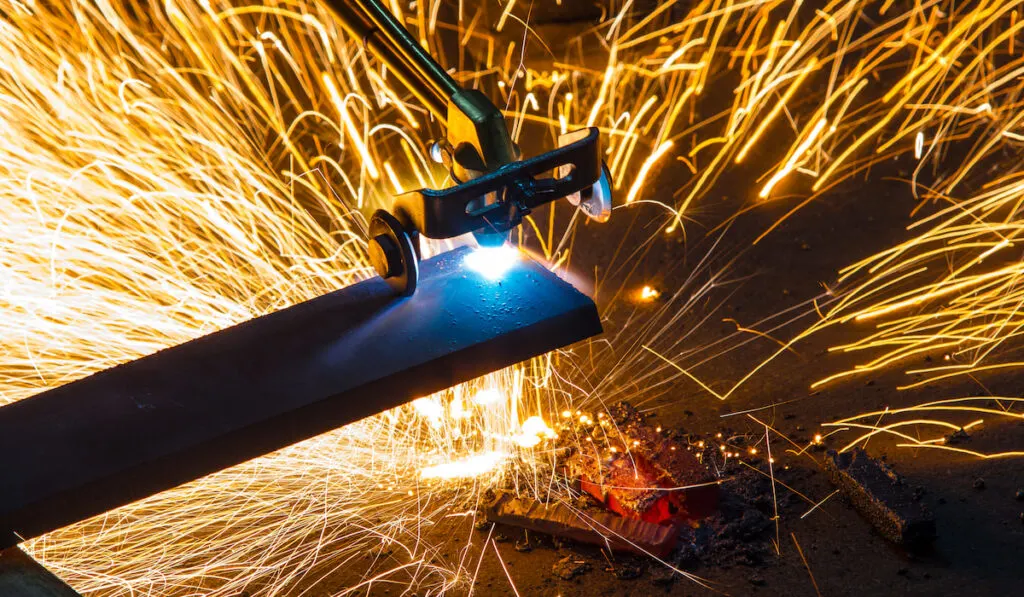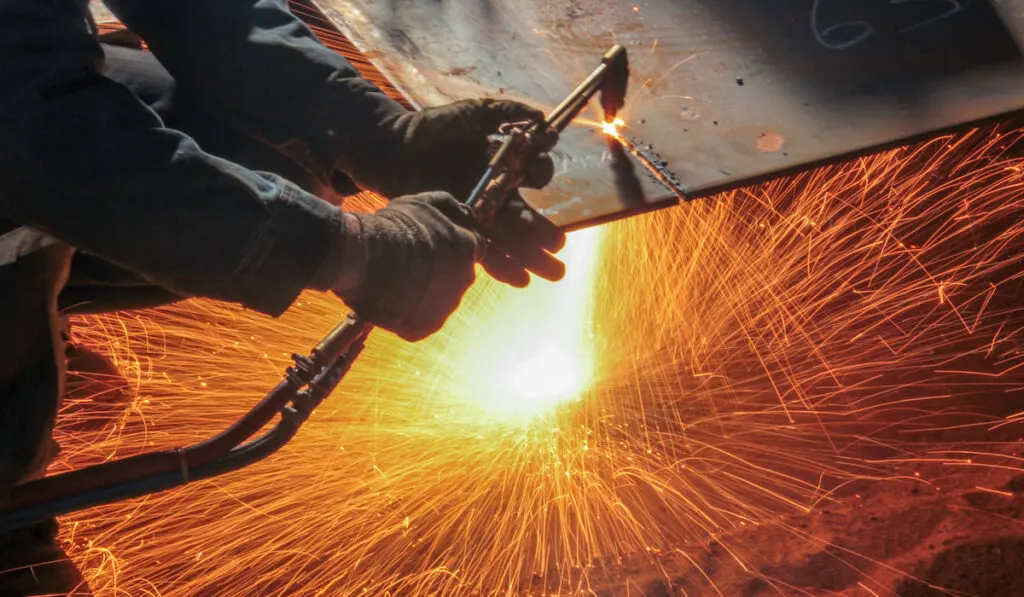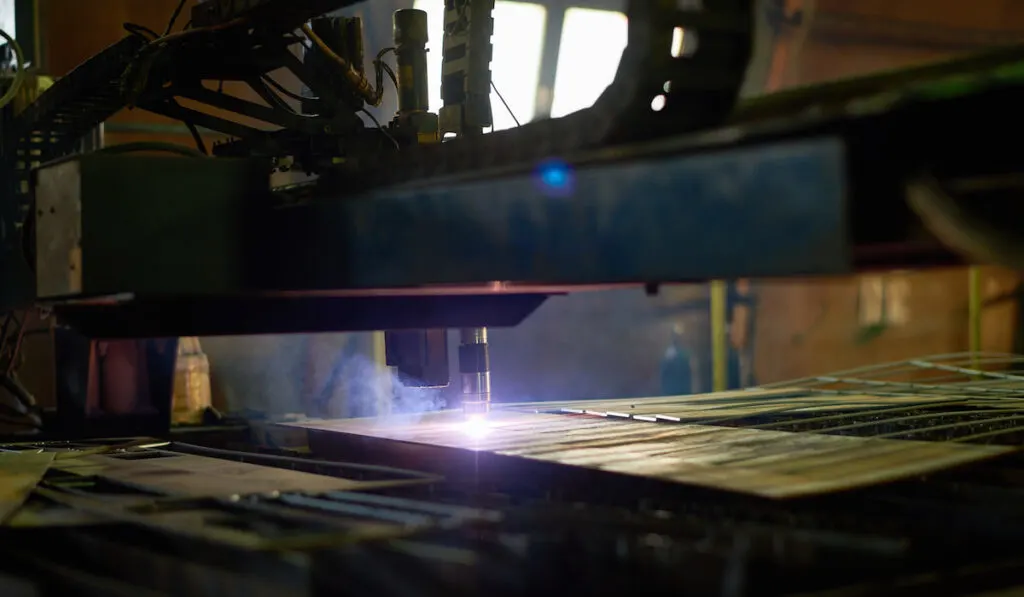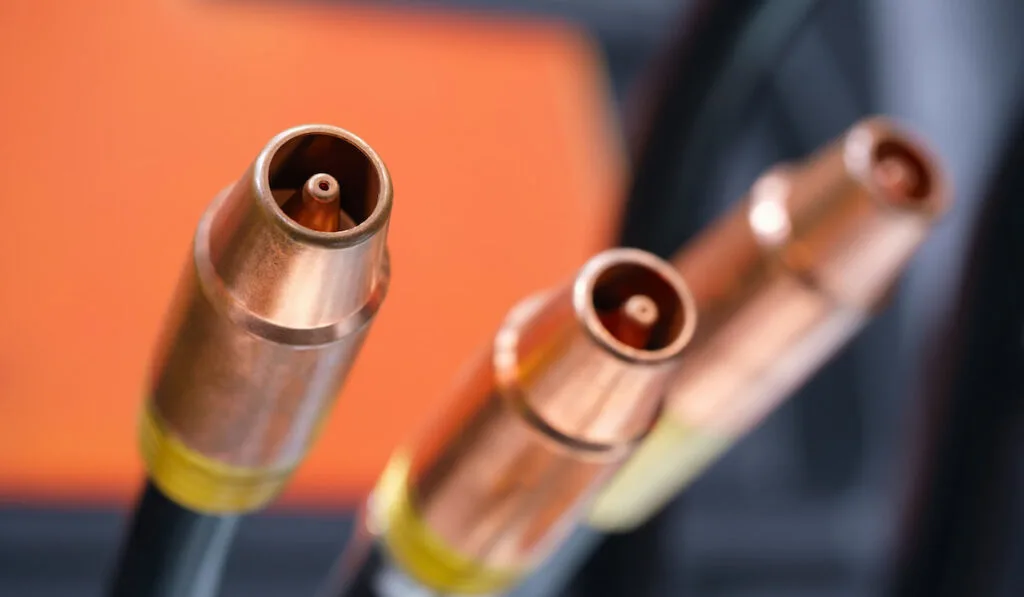*This post may have affiliate links, which means I may receive commissions if you choose to purchase through links I provide (at no extra cost to you). As an Amazon Associate, I earn from qualifying purchases. Please read my disclaimer for additional details.
Table of Contents
Metal Cutting Overview
Metal cutting processes involve removing metal particles to separate the desired parts from the undesired parts. Metal cutting is a process with a range of associated applications, mainly welding operations, either in the fabrication shop or on a worksite.
Besides the mechanical techniques that utilize drills, metal saws, and grinders to cut metal, heat and electrical energy can be used to create fast cuts through metal.
To complement the quick cuts through hard metals, cutting flames are efficient because of the decreased wear and tear on the equipment used.

Types of Cutting Torches
There are two standard metal cutting techniques: plasma and oxy-fuel cutting. Both methods have their advantages and disadvantages, but choosing the best fit for your job depends on quite a few factors. These factors include the thickness of the metal to be cut, power sources, the site location with its environment, and the cost.
Oxy-fuel torches have always been a popular choice for fieldwork because of being highly portable. However, technological advances are fast enhancing the plasma cutter to be a more portable choice.
Let’s have a more detailed look at these cutting tools.
1. Plasma Cutter
Plasma is an ionized conductor gas produced by adding electric energy to an electrically neutral gas, usually compressed air.
These elements mix in a chamber between an electrode and a nozzle, which ignites the gas, causing an imbalance in the gas, forming plasma gas.
The super-heated, imbalanced, and electrically conductive plasma gas melts the metal particles on its path. The high pressure helps to blow away the molten metal, effectively separating the metal pieces.
The flame temperature is monitored and regulated through the energy supplied.
More power gives a hotter plasma arc, which has more cutting capacity and greater efficiency.
Using a plasma cutter usually needs sources for both pressurized air and electric power, so it is essential to consider this when deciding whether to use a plasma cutter.
The typical hand-held plasma cutter cuts through an average metal thickness of 1 inch.
Advantages of plasma cutters
Below are some advantages of plasma cutters:
- Capability to cut a wide range of metals – Plasma cutters can cut non-ferrous metals such as aluminium, cast iron, and stainless steel (materials becoming increasingly common in a wide range of applications).
- Plasma torches produce cuts with more accuracy because they cut fast with little slag, resulting in clean cuts with a smaller kerf than oxy-fuel torches.
- Compared to oxy-fuel systems, plasma systems are simple to operate and have the advantage of requiring less cleaning after usage.
- Plasma torches can cut thinner metals faster than oxy-fuel torches while causing little to no metal deformation. Besides that, plasma provides superior performance when cutting stacked metals.
- Plasma cutting offers quicker and more accurate cutting performance when working with curved metals such as angles and tubes.
- It saves time and money since plasma does not need preheating of the metal before cutting.
- Safety advantages – Plasma systems do not need the storage or handling of dangerous gases, nor do they necessitate the use of an open flame.
2. Oxy-fuel Torches

Oxy-fuel cutting systems use oxygen to cut metals. An oxygen and fuel gas flame preheats the metal up to ignition temperature, then adds oxygen to increase the flame temperature, which burns away the undesired metal.
Upon contact with the metal surface, the oxygen flame’s heat causes the metal beneath to be oxidized into iron oxide (slag). This slag is swept away by the high air pressure, causing the separation of metal.
When using oxy-fuel torches, the type of fuel gas used influences the cut quality and preheating time. Acetylene, propane, propylene, and natural gas are the four leading gases combined with oxygen in oxy-fuel cutting torches.
Consideration for the best gas to use depends on the cutting application, heat output, cost, and oxygen consumption.
However, oxy-fuel torches only work on metals that readily oxidize, subsequently excluding copper, stainless steel, and aluminum.
Making a clean cut through these metal materials is difficult because as you try burning through, the metal oxides created have a higher melting point than the metal itself, meaning that you will end up melting the whole metal rod before burning a cut across.
Advantages of Oxy-fuel Torches
- Cuts thicker metals – The typical hand-held oxy-fuel torch can handle steel thickness of 6 – 12 inches, while some other sophisticated systems can cut up to or over 20 inches thick. This specific feature makes it desirable over plasma systems.
- Extended lengths – Most oxy-fuel torches are fitted with extendable lengths to keep the torch operator away from the flames, heat, and slag generated while cutting. The torch hoses are fixed to a series of cylinders on a mobile cart or a permanent header system. This also promotes mobility.
- High mobility – oxy-fuel torch systems are highly portable since they do not need any electric power. You can use the system at any place, as long as you have the oxy-fuel supply.
- Highly versatile – Oxy-fuel torches are used in various artisan applications, including cutting, welding, soldering, brazing, gouging and heating.
However, when using oxy-fuel cutting systems, you should bear in mind that this flame only cuts ferrous metals or those containing iron, like carbon steel. You also need to acquire the oxy-fuel to use it.
3. Laser Cutting

Laser cutters can separate metal by using a tightly focused beam of intense energy that heats the specific spot or line, then melts and vaporizes away the metal particles that it comes in contact with.
They are primarily computer-controlled to achieve clean and accurate cuts in applications where precise measurements of metals, including other materials, are needed.
Which is The Hottest Cutting Torch?
Oxy-fuel (oxy-acetylene) torches burn the hottest at around 5800 degrees.
On the other hand, oxy-propane torch flames burn at about 5300 degrees, slightly lower than the oxy-acetylene, and will take longer to preheat before cutting.
However, propane is popular in the market because it is a bit cheaper than acetylene. Learning how to handle the torch is essential for flexibility and versatility.
The oxy-acetylene torch uses oxygen for the cutting jet flame and acetylene to give the preheat flames. As the flame hits the metal surface, it induces rapid oxidation, which causes the metal to rust, producing slag that is blown away by the pressure, resulting in separate metal pieces.
Cutting torch tip sizes and why they matter

Cutting torch tip sizes vary depending on the type of flame they use and the application they may be required to perform. It is also essential to have suitable replacements for torch tips when worn out to avoid inconveniences during manual cutting.
To efficiently do this, three factors have to be addressed primarily:
- Model/Make of The Torch – Different cutting torches might have the same-looking seats, which might confuse you when looking for torch tip replacements. It is, therefore, good to know the model of the torch to be able to acquire and fit the appropriate replacement parts when necessary.
- Gas used – For optimal efficiency, every gas/fuel has its appropriate tip. For preheating efficiency, for example, there are heavier torch tips recommended for propane or acetylene gasses because these tips can handle the higher temperature.
- The thickness of the metal being cut – depending on the application, choosing a metal tip will always be guided by the hole size appropriate for the metal thickness you want to cut through. Thinner tip flames arephysically thinner and stronger, making them suitable for cutting through thick materials.
Cutting Torch Safety Tips
When working with cutting torches, it is always a good practice to take precautions and ensure a safe working environment. Let’s have a look at how you can achieve this.
- Pay close attention to your surroundings and what is going on, and analyze the consequences of your actions.
- Be cautious where you direct the flames when they ignite. The heat from cutting torches is so intense that they may burn almost everything they come in contact with.
- Keep your working area clean because slag alone can start a fire. If there are materials like rags, paper, or sawdust around the working area, watch out to ensure they are not burning because this could be hard to detect at first.
- You should keep all flammable substances away from the working area to avoid potential risks. These include but are not limited to paints, solvents, and gasoline, among other similar substances.
- Always have a fire extinguisher that you are familiar with for easy handling, and more significantly, one that can put out any kind of fire.
- Have on the appropriate safety gear. To begin with, a decent pair of safety boots and glasses are a must. By all means, you should avoid torn clothes or those made of synthetic materials. These materials will catch fire easily.
Conclusion
Compared to other methods, cutting flame torches are the most efficient for cutting metal.
However, choosing the suitable cutting flame depends on the desired application, the metal material to be cut, and thickness, among other factors.
For responsible operators, safety precautions are always the primary tasks on their lists.
Resources
- https://itstillruns.com/types-cutting-torches-6712687.html
- http://www.tpub.com/steelworker1/37.htm
- https://www.millerwelds.com/resources/article-library/choosing-between-oxy-fuel-and-plasma-cutting-systems
- https://americantorchtip.com/blog/how-to-select-the-correct-cutting-tips-oxy-fuel/
- https://www.wcwelding.com/cutting-torch.html
- https://ronsonstorch.com/selecting-the-right-cutting-tip/
